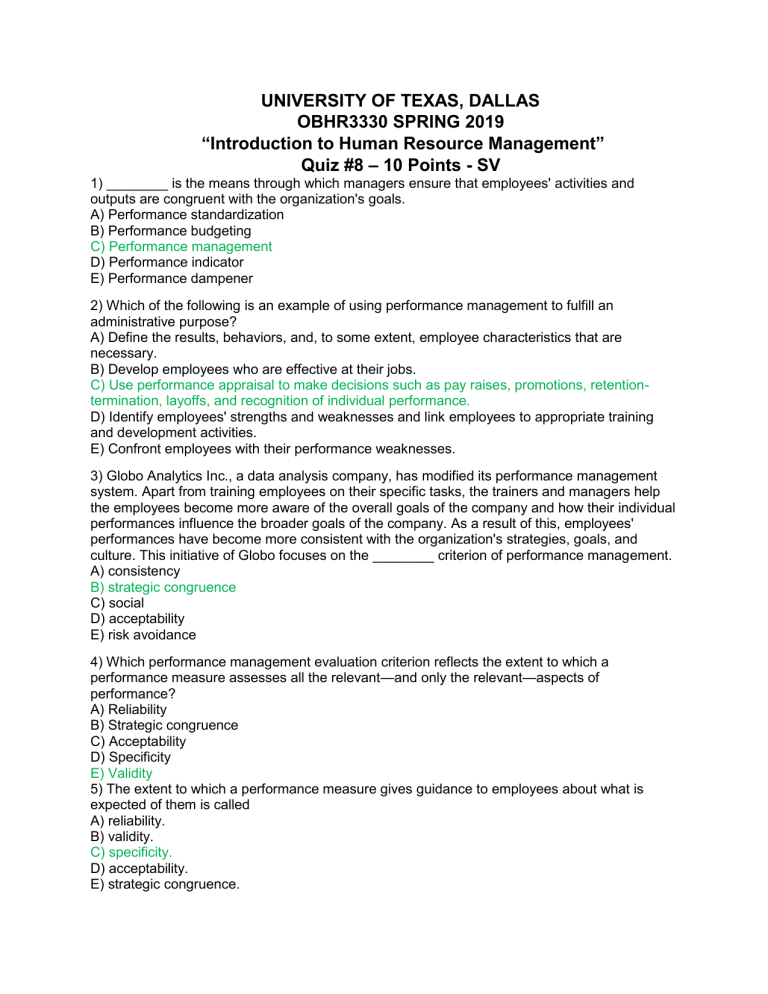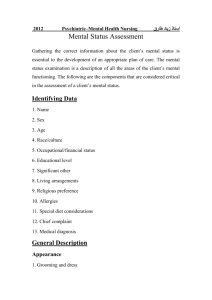
UNIVERSITY OF TEXAS, DALLAS OBHR3330 SPRING 2019 “Introduction to Human Resource Management” Quiz #8 – 10 Points - SV 1) ________ is the means through which managers ensure that employees' activities and outputs are congruent with the organization's goals. A) Performance standardization B) Performance budgeting C) Performance management D) Performance indicator E) Performance dampener 2) Which of the following is an example of using performance management to fulfill an administrative purpose? A) Define the results, behaviors, and, to some extent, employee characteristics that are necessary. B) Develop employees who are effective at their jobs. C) Use performance appraisal to make decisions such as pay raises, promotions, retentiontermination, layoffs, and recognition of individual performance. D) Identify employees' strengths and weaknesses and link employees to appropriate training and development activities. E) Confront employees with their performance weaknesses. 3) Globo Analytics Inc., a data analysis company, has modified its performance management system. Apart from training employees on their specific tasks, the trainers and managers help the employees become more aware of the overall goals of the company and how their individual performances influence the broader goals of the company. As a result of this, employees' performances have become more consistent with the organization's strategies, goals, and culture. This initiative of Globo focuses on the ________ criterion of performance management. A) consistency B) strategic congruence C) social D) acceptability E) risk avoidance 4) Which performance management evaluation criterion reflects the extent to which a performance measure assesses all the relevant—and only the relevant—aspects of performance? A) Reliability B) Strategic congruence C) Acceptability D) Specificity E) Validity 5) The extent to which a performance measure gives guidance to employees about what is expected of them is called A) reliability. B) validity. C) specificity. D) acceptability. E) strategic congruence. 6) Every year managers are given targets for categorizing their employees' performance at the end of the year. The managers are allowed 5 percent at the top, 80 percent in the middle and then 15 percent at the bottom. This company is using A) forced distribution. B) the high/low ranking system. C) paired comparison. D) alternation ranking. E) simple ranking. 7) Which of the following is true about the results approach to performance management? A) The results approach relies primarily on a combination of the attribute and results approaches to performance measurement. B) The results approach virtually eliminates problems of leniency, central tendency, and strictness. C) The techniques of the results approach usually have very little congruence with the company's strategy. D) The results approach is usually highly unacceptable to both managers and employees. E) The results approach minimizes subjectivity, relying on objective, quantifiable indicators of performance. 8) When gathering information on performance, HR relies on ________ more frequently than any other group, because they will have the most accurate information. A) peers B) managers C) subordinates D) employees themselves E) customers 9) Appraisals that involve collecting subordinates' evaluations of a manager's behavior or skills are known as A) 360-degree feedback. B) screening interviews. C) peer review. D) social performance. E) upward feedback. 10) Harriet wants all of her team members to receive a raise, so she gives them all a high rating. Which of the following errors is she falling prey to? A) Halo B) Contrast C) Central tendency D) Leniency E) Similar to me
